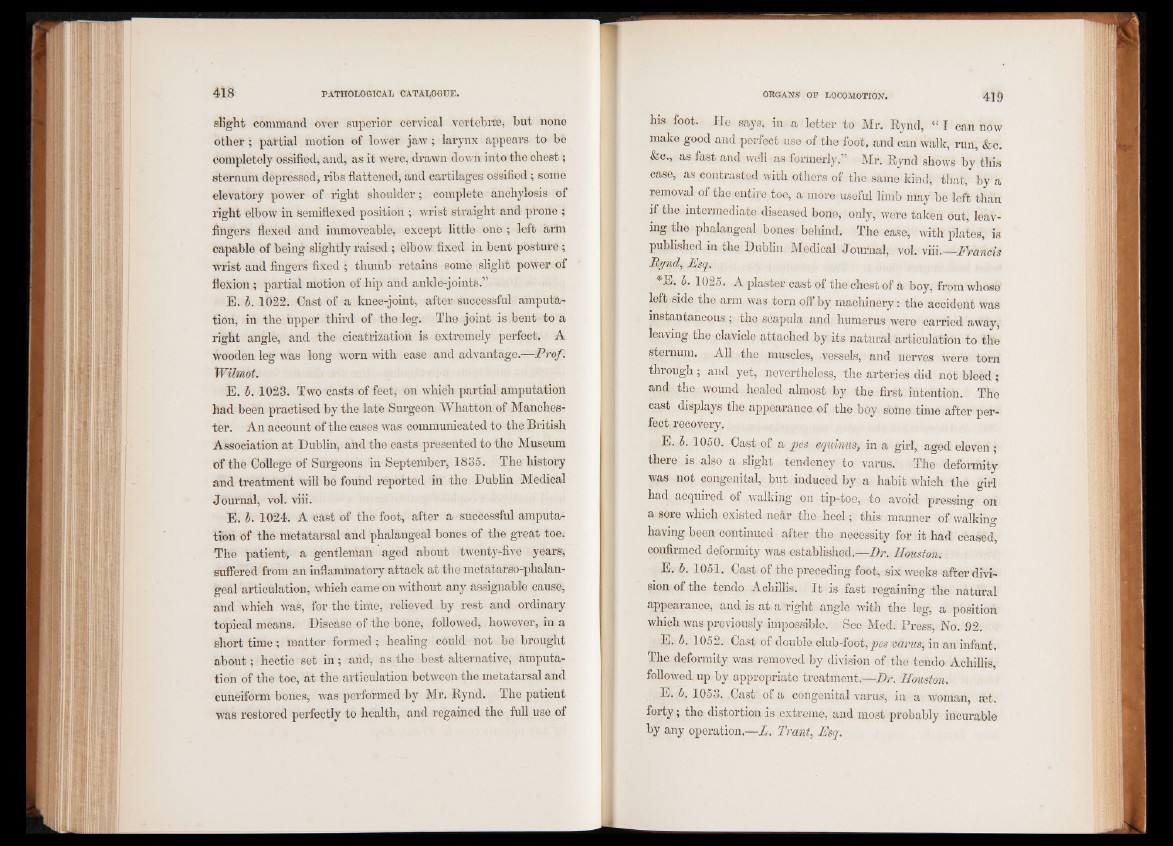
slight command over superior cervical vertebrae, but none
other; partial motion of lower jaw; larynx appears to be
completely ossified, and, as it were, drawn down into the chest;
sternum depressed, ribs flattened, and cartilages ossified; some
elevatory power of right shoulder; complete anchylosis of
right elbow in semiflexed position ; wrist straight and prone ;
fingers flexed and immoveable, except little one ; left arm
capable of being slightly raised ; elbow fixed in bent posture;
wrist and fingers fixed ; thumb retains some slight power of
flexion ; partial motion of hip and ankle-joints.”
E. b. 1022. Cast of a knee-joint, after successful amputation,
in the upper third of the leg. The joint is bent to a
right angle, and the cicatrization is extremely perfect. A
wooden leg was long worn with ease and advantage.—Prof.
Wilmot.
E. b. 1023. Two casts of feet, on which partial amputation
had been practised by the late Surgeon Whatton of Manchester.
An account of the cases was communicated to the British
Association at Dublin, and the casts presented to the Museum
of the College of Surgeons in September, 1835. The history
and treatment will be found reported in the Dublin Medical
Journal, vol. viii.
E. b. 1024. A cast of the foot, after a successful amputation
of the metatarsal and phalangeal bones of the great toe.
The patient, a gentleman aged about twenty-five years,
suffered from an inflammatory attack at the metatarso-phalan-
geal articulation, which came on without any assignable cause,
and which was, for the time, relieved by rest and ordinary
topical means. Disease of the bone, followed, however, in a
short time; matter formed ; healing could not be brought
about; hectic set in; and, as the best alternative, amputation
of the toe, at the articulation between the metatarsal and
cuneiform bones, was performed by Mr. Rynd. The patient
was restored perfectly to health, and regained the full use of
his foot. He says, in a letter to Mr. Rynd, “ I can now
make good and perfect use of the foot, and can walk, run, &c.
&c., as fast and well as formerly.” Mr. Rynd shows by this
case, as contrasted with others of the same kind, that, by a
removal of the entire toe, a more useful limb may be left than
if the intermediate diseased bone, only, were taken out, leaving
the phalangeal bones behind. The case, with plates, is
published in the Dublin Medical Journal,Rynd, Esq. vol. viii .—Francis
*E. b. 1025. A plaster cast of the chest of a boy, from whose
left side the arm was torn off by machinery: the accident was
instantaneous; the scapula and humerus were carried away,
leaving the clavicle attached by its natural articulation to the
sternum. All the muscles, vessels, and nerves were torn
through ; and yet, nevertheless, the arteries did not bleed ;
and the wound healed almost by the first intention. The
cast displays the appearance of the boy some time after perfect
recovery.
E. b. 1050. Oast of a pes equinus, in a girl, aged eleven;
there is also a slight tendency to varus. The deformity
was not congenital, but induced by a habit which the girl
had acquired of walking on tip-toe, to avoid pressing on
a sore which existed near the heel; this manner of walking
having been continued after the necessity for it had ceased,
confirmed deformity was established.—Dr. Houston.
E. b. 1051. Cast of the preceding foot, six weeks after division
of the tendo Achillis. It is fast regaining the natural
appearance, and is at a right angle with the leg, a position
which was previously impossible. See Med. Press, No. 92.
E. b. 1052. Oast of double club -foot, pes varus, in an infant.
The deformity was removed by division of the tendo Achillis,
followed up by appropriate treatment.—Dr. Houston.
E. b. 105o. Oast of a congenital varus, in a woman, jet.
forty; the distortion is extreme, and most probably incurable
by any operation.—L. Trant, Esq.